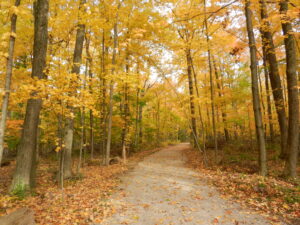By Uriah St. John, Seasonal Naturalist
 As we move from summer into autumn it is time for the leaves to start changing. This changing of colors is the symbol of the season and reminds people everywhere of autumn. But have you ever stopped to wonder how or why this happens? Or if there are also other things trees do to prepare for winter? Well, stick with me for another few paragraphs and you will soon find out.
As we move from summer into autumn it is time for the leaves to start changing. This changing of colors is the symbol of the season and reminds people everywhere of autumn. But have you ever stopped to wonder how or why this happens? Or if there are also other things trees do to prepare for winter? Well, stick with me for another few paragraphs and you will soon find out.
Leaves are green during the spring and summer because of the chlorophyl in them that they use for photosynthesis. As late summer comes and goes, trees sense the days getting shorter. Once the daily amount of sunlight gets low enough, they know it is time to prepare for winter. The first thing that happens is the breakdown of the chlorophyl in the leaves. This causes the leaves to change color. The green chlorophyl breaks down and reveals other colors in the leaves.
While this is going on, trees also begin to pull nutrients out of their leaves. They know nitrogen and phosphorus are vital nutrients that cannot be wasted by letting them fall to the ground inside leaves. In fact, the trees know the value of these nutrients to a T. In places where nitrogen and phosphorous are less common, trees will pull even more out of their autumn leaves, squeezing out every bit of nutrients before the leaves fall. This process of pulling the nutrients out of leaves is known as nutrient translocation, because the nutrients are being moved to a new location in the plant. Once this process is complete, the trees form a group of cells at the base of leaves where they meet the tree. These cells will cut off the leaves from their branches and allow them to fall to the ground.

There is still one more process trees must undergo before they are ready for winter: cold hardening. Cold hardening is the process of plants preparing their cells for freezing winter temperatures. There are two main ways deciduous trees cold harden: sugar concentration and cell dehydration. Sugar concentration is when a plant pushes lots of sugars into the water in their cells. This lowers the water’s freezing point in a process called supercooling. Other trees prevent their cells from freezing through cell dehydration, where they will simply pull all the water out of their cells. This way there is simply no water in their cells that can be frozen. Trees and other woody plants may not move or gather food like animals, but they still do a lot of work to do to prepare for winter. Who knew?
Come see this process in action this fall at a PPDC park near you.






